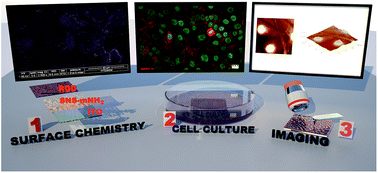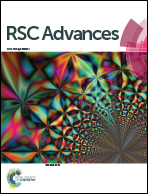Peptide-modified conducting polymer as a biofunctional surface: monitoring of cell adhesion and proliferation†
Abstract
Here, we report the electropolymerization of 3-(2,5-di(thiophen-2-yl)-1H-pyrrol-1-yl)aniline monomer on indium tin oxide (ITO) glass and its use as a coating material for cell culture applications. Functional amino groups on the conducting polymer provide post-modification of the surface with the arginylglycylaspartic acid (RGD) peptide via EDC chemistry. Scanning electron microscopy, atomic force microscopy, and contact angle and surface conductivity measurements were carried out for the surface characterization. The peptide-conjugated surface was tested for adhesion and proliferation of several cell lines such as monkey kidney epithelial (Vero), human neuroblastoma (SH-SY5Y), and human immortalized skin keratinocyte (HaCaT). These cells were cultured on RGD-modified, polymer-coated ITO glass as well as conventional polystyrene surfaces for comparison. The data indicate that the RGD-modified surfaces exhibited better cell adhesion and proliferation among all surfaces compared. Cell imaging studies up to 72 h in length were performed on these surfaces using different microscopy techniques. Therefore, the novel biofunctional substrate is a promising candidate for further studies such as monitoring the effects of drugs and chemicals on cellular viability and morphology as well as cell-culture-on-a-chip applications.


 Please wait while we load your content...
Please wait while we load your content...